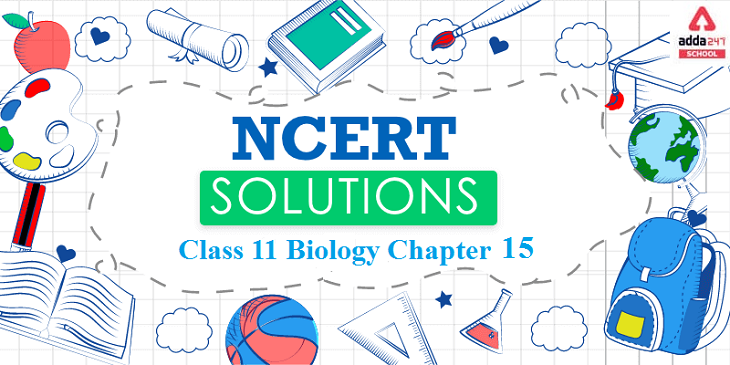Ncert Solutions For Class 11 Biology Chapter 15 in English
Adda 247 provides NCERT Solutions for Class 11 Biology Chapter 15 which is for the students who want to go ahead in life and achieve great marks in their examinations. The NCERT Solutions for class 11 Biology Chapter 15 are provided by the teachers who are experts in their subjects. The solutions are set according to the rules formulated by the NCERT class 11 biology and in the language that can be understood by every student. By reading the solutions students can build up a strong base easily. The NCERT class 11 Biology solutions cover chapters 1 to 22 with the important questions and the answers in a detailed way.
Examinations can be threatening for some people, a proper learning of the concepts is the key to crack the examination. Students rely on the solutions of the NCERT provided by Adda 247. The solutions are formulated by the experts of the subjects who have tremendous knowledge in their subjects.
These NCERT Solutions of class 11 help the students to get familiarized with the textbooks. The students can access the solutions anywhere while browsing the web easily. The solutions are very precise and accurate.
NCERT Solutions for Class 11 Biology Chapter 15 – Plant growth and development
The Ncert Solutions For Class 11 Biology Chapter 15 provides information about Plant growth and development. Growth is a characteristic of living beings in which an irreversible permanent increase in the size of an organ or its parts occurs or an increase in the size of a cell. Growth rate can be defined as the increase in growth per unit time. Plants show two types of growth—Arithmetic and Geometric—according to the increase shown by the growth rate. Arithmetic growth – Only one daughter cell continues to divide while others differentiate or mature. Example − root elongating at a constant rate. Geometric Growth – Initial growth is slow (lag phase), followed by a rapid increase in growth (log/exponential phase), and followed by a phase where growth slows down (stationary phase). For example − all cells, tissues, and organs show this type of growth.
[sso_enhancement_lead_form_manual title=”Download Full PDF of Class 11 Biology Chapter 15 ” button =”Download Now” pdf =”/jobs/wp-content/uploads/2021/06/21105529/English-chapter-15.pdf”]
Features of the NCERT Solutions for Class 11 Biology Chapter 15 – Plant growth and development
NCERT Solutions for Class 11 Biology chapter 15 have been answered based on the important information on the question.
- The columns are used wherever necessary.
- Solutions are solved point-wise and accurately answered point to point.
Important Question of NCERT Solutions for Class 11 Biology Chapter 15
Question 1. Define growth, differentiation, development, dedifferentiation, development, redifferentiation, determinate growth, meristem and growth rate.
Answer:
(a) Growth:
It is an irreversible and permanent process, accomplished by an increase in the size of an organ or organ parts or even of an individual cell.
(b) Differentiation:
It is a process in which the cells derived from the apical meristem (root and shoot apex) and the cambium undergo structural changes in the cell wall and the protoplasm, becoming mature to perform specific functions.
(c) Development:
It refers to the various changes occurring in an organism during its life cycle – from the germination of seeds to senescence.
(d) De-differentiation:
It is the process in which permanent plant cells regain the power to divide under certain conditions.
(e) Re-differentiation: It is the process in which de-differentiated cells become mature again and lose their capacity to divide.
(f) Determinate growth: It refers to limited growth. For example, animals and plant leaves stop growing after having reached maturity.
(g) Meristem: In plants, growth is restricted to specialized regions where active cell divisions take place. Such a region is called meristem. There are three types of meristems – apical meristem, lateral meristem, and intercalary meristem.
(h) Growth rate: It can be defined as the increased growth in plants per unit time.
Question 2. Why is not any one parameter good enough to demonstrate growth throughout the life of a flowering plant?
Answer: In plants, growth is said to have taken place when the number of protoplasm increases. The growth of protoplasm is measured by keeping into account many parameters such as the weight of the fresh tissue sample, the weight of the dry tissue sample, the differences in length, area, volume, and cell number measured during the growth period. The measurement of the growth of plants requires only one parameter that does not provide sufficient information and is insufficient for demonstrating growth.
Question 3. Describe briefly:
(a) Arithmetic growth
(b) Geometric growth
(c) Sigmoid growth curve
(d) Absolute and relative growth rates
Answer:
(a) Arithmetic growth
In arithmetic growth, one of the daughter cells continues to divide, while the other differentiates into maturity. The elongation of roots at a constant rate is an example of arithmetic growth.
(b) Geometric growth
Geometric growth is characterized by slow growth in the initial stages and rapid growth during the later stages. The daughter cells derived from mitosis retain the ability to divide but slow down because of a limited nutrient supply.
(c) Sigmoid growth curve
The growth of living organisms in their natural environment is characterized by an S-shaped curve called a sigmoid growth curve. This curve is divided into three phases – lag phase, log phase or exponential phase of rapid growth, and stationary phase.
(d) Absolute and relative growth rates
Absolute growth rate refers to the measurement and comparison of total growth per unit time.
Relative growth rate refers to the growth of a particular system per unit time, expressed on a common basis.
Question 4. List five main groups of natural plant growth regulators. Write a note on discovery, physiological functions and agricultural/horticultural applications of any one of them.
Answer: Five main groups of plant growth regulators are auxin, gibberellins, cytokinnins, abscisic acid and ethylene.
Discovery of Gibberellin
Gibberellins were discovered in Japan from rice plants suffering from bakane or foolish seedling disease. Such rice plants were thin, pale green spindle-shaped, longer by 50 % than the healthy plants and were sterile.. The disease was found by Hori and Kurosawa to be caused by Gibberella
fujikori. This fungus is the perfect stage of Fusarium moniliforme. He also reported that active substance from this fungus caused the appearance of symptoms. Later Yabuta separated and named this active substance as gibberellin.
Physiological functions
- Gibberellins help in the growth of stem, leaves and other aerial parts and cause an increase in their size and height
- Gibberellins can specifically induce internodal growth in some genetically dwarf varieties of plants like pea and maize etc.
- Gibberellins induce subapical meristem to develop faster. This causes elongation of reduced stem or bolting in case of rosette plants
- Gibberellins overcome the natural dormancy of buds, tubers, seeds, etc.
- Gibberellins through a cascade of events solubilize the reserve food in seeds and lead to their germination.
Agricultural/horticultural applications of gibberellins
- Application of gibberellins increases the number and size of several fruits such as grape, tomato etc. Size and shape can also be enhanced by using GA7 and GA4.
- Seedless parthenocarpic fruits can be produced by the application of gibberellins.
3. Spraying of sugarcane crop with gibberellin increases the length of the stem and yield of sugarcane.
Question 5. What do you understand by photoperiodism and vernalisation? Describe their significance.
Answer: Photoperiodism refers to the response of plants with respect to the duration of light (i.e., period of day and night). On the basis of its response to the duration of light, a plant is classified as a short-day plant, a long-day plant, or a day-neutral plant. Short-day plants flower when they are exposed to light for a period less than the critical day-length (for example: Chrysanthemum). Long-day plants flower when they are exposed to light for a period more than the critical day-length (for example: radish). When no marked correlation is observed between the duration of exposure to light and the flowering response, plants are termed as day-neutral plants (for example: tomato).
It is hypothesised that the hormonal substance responsible for flowering is formed in the leaves, subsequently migrating to the shoot apices and modifying them into flowering apices. Photoperiodism helps in studying the response of flowering in various crop plants with respect to the duration of exposure to light.
Vernalisation is the cold-induced flowering in plants. In some plants (such as the winter varieties of wheat and rye and biennials such as carrot and cabbage), exposure to low temperature is necessary for flowering to be induced. The winter varieties of rye and wheat are planted in autumn. They remain in the seedling stage during winters and flower during summers. However, when these varieties are sown in spring, they fail to flower. Similar response is seen in cabbage and radish.
Question 6. Why is abscisic acid also known as stress hormone?
Answer: Abscisic acid is called stress hormones as it induces various responses in plants against stress conditions. It increases the tolerance of plants toward various stresses. It induces the closure of the stomata during water stress. It promotes seed dormancy and ensures seed germination during favourable conditions. It helps seeds withstand desiccation. It also helps in inducing dormancy in plants at the end of the growing season and promotes abscission of leaves, fruits, and flowers.
Question 7. ‘Both growth and differentiation in higher plants are open’. Comment.
Answer: Plant growth is unique because plants retain the capacity for unlimited growth throughout their life. This ability of the plants is due to the presence of meristems at certain locations in their body. The cells of such meristems have the capacity to divide and self-perpetuate. The product, however, soon loses the capacity to divide and such cells make up the plant body. This form of growth wherein new cells are always being added to the plant body by the activity of the meristem is called the open form of growth.
Question 8. ‘Both a short day plant and a long day plant can produce flower simultaneously in a given place’. Explain.
Answer: The flowering in plants is in response to duration period of light or relative length of light.
The long day plants need a longer duration of light whereas the short day plants need a short duration
of light.
If the long day plant and the short day plants gets the required duration of the light necessary of their
flowering they may produce flower simultaneously in a given place. If the long day plants is planted
before the short day one such that the long day plants gets a longer duration of light, both the short day
plant and a long day plant can produce flower simultaneously in a given place.
Question 9. Which one of the plant growth regulators would you use if you are asked to:
(a) induce rooting in a twig
(b) quickly ripen a fruit
(c) delay leaf senescence
(d) induce growth in axillary buds
(e) ‘bolt’ a rosette plant
(f) induce immediate stomatal closure in leaves
Answer:
(a) auxins
(b) ethylene
(c) cytokinnins
(d) cytokinnins
(e) gibberellins
(f) abscisic acid.
Question 10. Would a defoliated plant respond to the photoperiodic cycle? Why?
Answer: A defoliated plant does not respond to the photoperiodic cycle at all. This is because the site of
perception of light or dark stimuli is the leaves. Leaves have the hormone florigen that makes them
capable of responding to the stimulus of photoperiodicity. So in the absence of any foliage over the plant, there is no response towards the photoperiodic cycle









 AILET 2026 AIR 1: Check Full Toppers Lis...
AILET 2026 AIR 1: Check Full Toppers Lis...
 AILET Result 2026 OUT, How to Download S...
AILET Result 2026 OUT, How to Download S...
 CUET PG Crash Course 2026: Subject-Wise ...
CUET PG Crash Course 2026: Subject-Wise ...














